OS - Windows: Difference between revisions
No edit summary |
|||
| Line 54: | Line 54: | ||
===Try it Out!=== | ===Try it Out!=== | ||
In order to try the Phidget Network Server out, first download and install [https:// | In order to try the Phidget Network Server out, first download and install [https://support.apple.com/kb/DL999 Bonjour for Windows] on your host computer and your client computer. | ||
*'''Host computer:''' the computer that is physically connected to the Phidgets via USB and is running the Phidget Network Server. | *'''Host computer:''' the computer that is physically connected to the Phidgets via USB and is running the Phidget Network Server. | ||
*'''Client computer:''' a computer running a Phidgets application that accesses Phidgets connected to the host computer. | *'''Client computer:''' a computer running a Phidgets application that accesses Phidgets connected to the host computer. | ||
Revision as of 16:48, 4 February 2019
Getting Started with WindowsWelcome to using Phidgets with Windows! If you are ready to go, the first step in creating Windows applications with Phidgets is installing our libraries. |
Install
To install our libraries, download the installer for your system:
Before installing our libraries, be sure to read our Software License.
When prompted, continue with the installation:
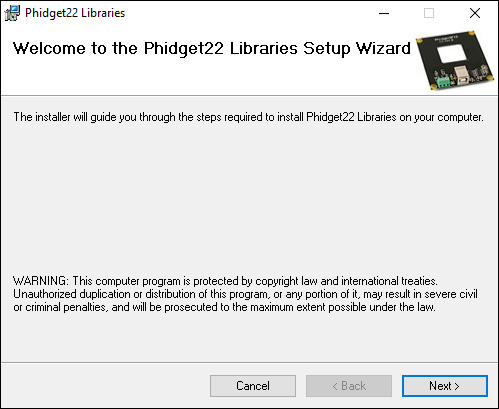
The libraries are now installed on your machine. Next, let's verify that they are working properly.
For instructions on installing our libraries without an installer, check out the OS - Windows Advanced Information page.
Verify
The best way to verify that your libraries are working properly is to use the Phidget Control Panel. The control panel is a powerful tool that will help you develop your Phidgets applications. Get started by following the instructions below:
Find the ![]() icon in the taskbar. If it is not there, open up the start menu and search for Phidget Control Panel
icon in the taskbar. If it is not there, open up the start menu and search for Phidget Control Panel
Next, double-click on the Phidgets icon to bring up the Phidget Control Panel. You can now see all the Phidgets that are plugged into your machine, as well as any Phidgets that are on the network:
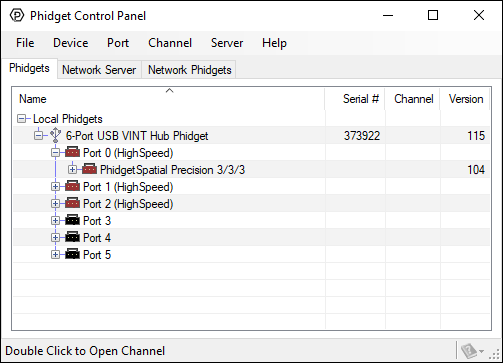
Click on the + beside a device to expand it so that you can see all available channels. Double-click on one of these channels to open up a window that lets you interact with it.:
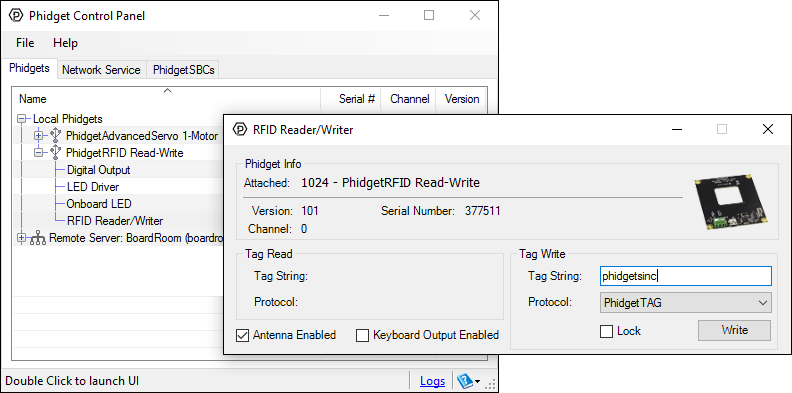
The Phidget Control Panel can be used for testing devices, updating firmware, enabling a Phidget Network Server, and more! Visit the Phidget Control Panel page for more information.
Your Phidget is now able to communicate with your development machine. The next step is selecting a programming language so you can start to write some code!
Programming
Ready to write some code? Select one of the programming languages below:
Phidget Network Server
The Phidget Network Server is an extremely useful tool that allows you to remotely control Phidgets over your network. If you haven't already, check out the Phidget Network Server page for a complete overview.
Try it Out!
In order to try the Phidget Network Server out, first download and install Bonjour for Windows on your host computer and your client computer.
- Host computer: the computer that is physically connected to the Phidgets via USB and is running the Phidget Network Server.
- Client computer: a computer running a Phidgets application that accesses Phidgets connected to the host computer.
If you only have one computer, don't worry, your machine can act as both a host and a client.
Next, open the Phidget Control Panel on your host computer. Do this by double-clicking on the ![]() icon in your taskbar, or by searching for Phidget Control Panel in the start menu.
Navigate to the Network Server tab, you will see something like this:
icon in your taskbar, or by searching for Phidget Control Panel in the start menu.
Navigate to the Network Server tab, you will see something like this:
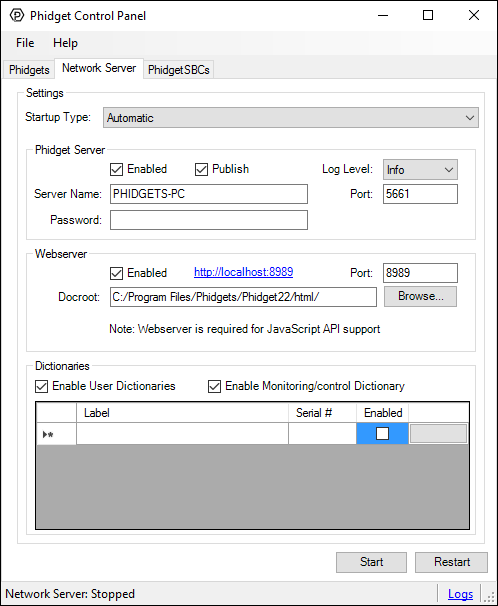
From here, you can start, stop, or restart the Network Server. You can also decide how and when the Network Server will start.
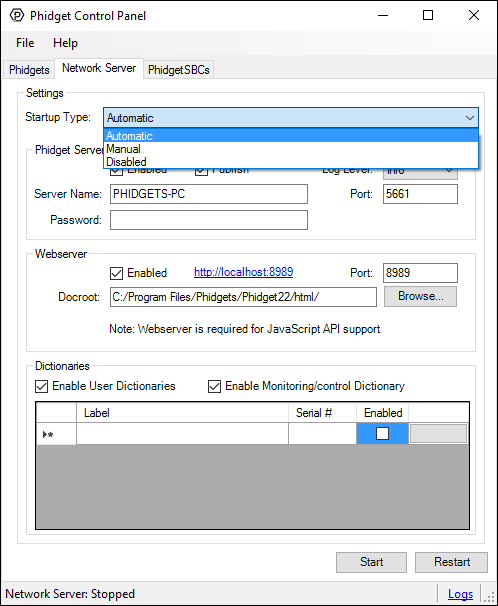
Select Automatic as the startup type from the list and press the start button. By enabling automatic startup, the Network Server will run immediately after Windows boots, so you won't have to manually start it again.
Now that you have the Network Server running on your host computer, the next step will be accessing the Phidgets connected to your host computer from your client computer. Follow the steps below:
Open the Phidget Control Panel on your client computer. You will see something like this:
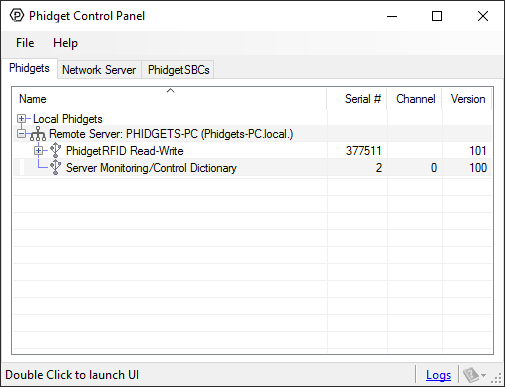
As you can see from the image above, Phidget servers are listed under the following heading:
- Remote Server: Servername (link local address)
You now have access to the Phidgets that are connected to your host computer. Try double-clicking one of them to bring up an example:

Note the label in the example indicating a remote connection. This means the example is using the Phidget Network Server in order to communicate with the device.
What's Next?
Now that you have seen the Phidget Network Server in action, you may be interested in implementing an application that takes advantage of all it's features. Luckily, every programming language we support comes with example code on how to do this! Jump to programming languages above.
For more information about the Network Server tab on the Phidget Control Panel, visit the Visit the Phidget Control Panel page.
Advanced Information
For information on advanced Windows topics, such as installing our libraries without an installer, installing our libraries without an internet connection, or using Windows in a Virtual Machine, check our page on Windows Advanced Information









